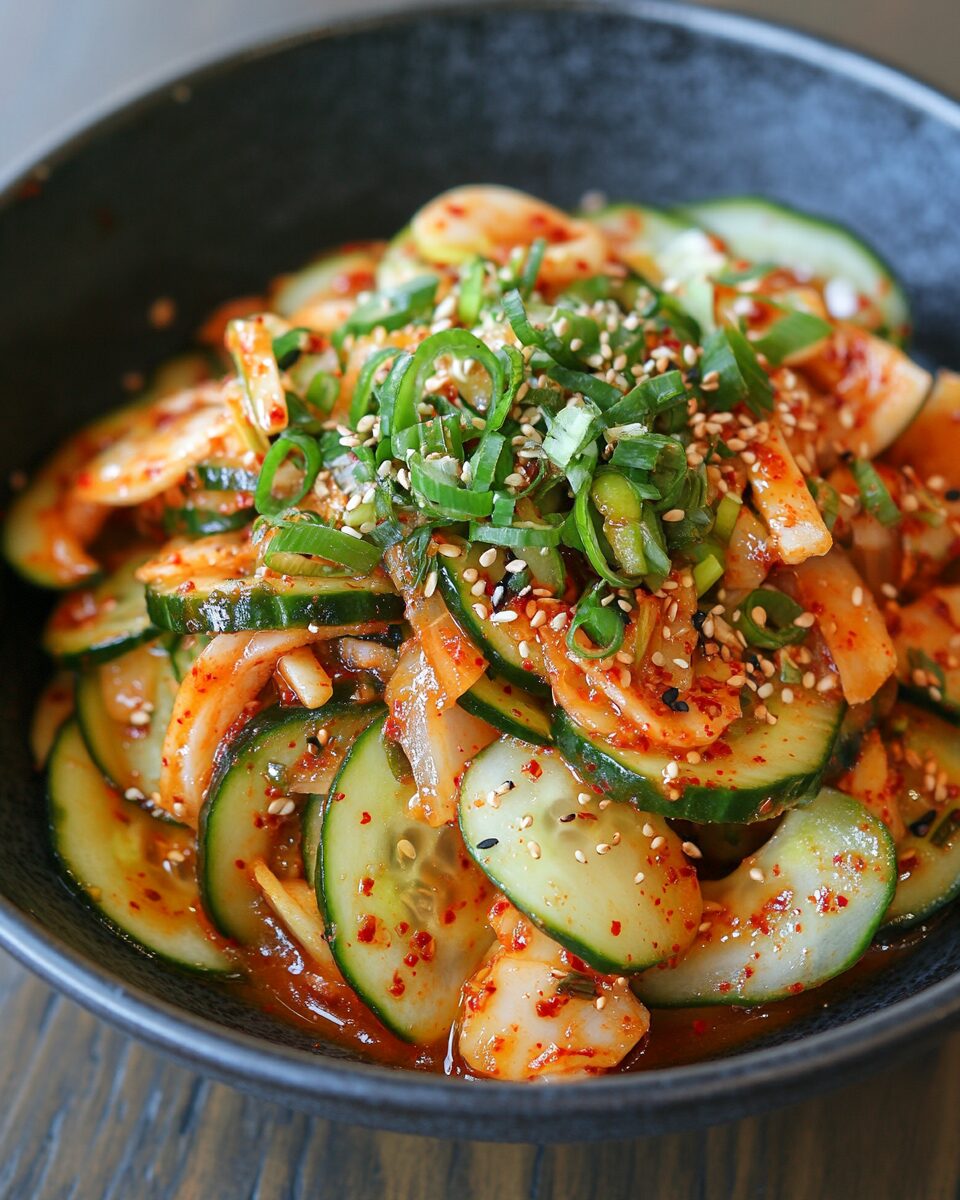The Spicy Korean Cucumber Salad, known as “Oi Muchim” in Korean, is a staple side dish that delivers an unforgettable burst of flavor with every bite. With a balance of heat, tang, and refreshing crunch, it’s one of the easiest ways to add authentic Korean flair to any meal. The use of gochugaru, garlic, and vinegar gives it a punchy attitude, while sesame oil and seeds mellow it out with a rich nuttiness.
This quick, no-cook recipe is perfect for hot days or busy nights. It’s naturally vegan and gluten-free, making it an ideal dish for various dietary preferences. Serve it as a side to Korean BBQ, mix it into rice bowls, or enjoy it straight from the bowl. Whether you’re new to Korean cuisine or a seasoned fan, this salad is a guaranteed crowd-pleaser.
Full recipe:
Ingredients:
-
4 Korean cucumbers (or Persian cucumbers), thinly sliced
-
1 tablespoon sea salt
-
2 green onions, finely chopped
-
1 tablespoon Korean red pepper flakes (gochugaru)
-
2 teaspoons sugar
-
1 tablespoon rice vinegar
-
1 tablespoon sesame oil
-
2 teaspoons minced garlic
-
1 teaspoon soy sauce
-
1 teaspoon toasted sesame seeds
Directions:
-
Place the sliced cucumbers in a bowl and sprinkle with sea salt. Toss to coat evenly and let them sit for 15–20 minutes to draw out moisture.
-
After 20 minutes, rinse the cucumbers with cold water to remove excess salt and gently squeeze out the water.
-
In a separate mixing bowl, combine gochugaru, sugar, rice vinegar, sesame oil, minced garlic, soy sauce, and chopped green onions. Mix well until sugar dissolves.
-
Add the drained cucumbers to the seasoning mix and toss until the cucumbers are evenly coated.
-
Let the salad sit for 5–10 minutes to absorb flavors.
-
Sprinkle with toasted sesame seeds just before serving.
Prep Time: 10 minutes | Resting Time: 20 minutes | Total Time: 30 minutes
Kcal: 60 kcal | Servings: 4 servings
Cultural Significance of Banchan and the Role of Oi Muchim
To fully appreciate Oi Muchim, it helps to understand the concept of banchan in Korean cuisine. Banchan refers to the small side dishes that accompany rice and a main dish in a traditional Korean meal. They are usually shared family-style and often include fermented vegetables (like kimchi), stir-fried greens, small bites of protein, and pickled or seasoned dishes.
Oi Muchim holds a special place among banchan because it’s quick to prepare and doesn’t require fermentation. It offers immediate gratification, contrasting with longer-prepared sides like kimchi. It also provides a balance to heavier dishes like Korean BBQ (galbi), spicy stews (jjigae), or fried meats. Its bright, clean flavor and light texture offer a refreshing counterpoint on the palate, enhancing the overall dining experience.
Flavor Profile and Texture
What makes this dish stand out is its bold yet balanced flavor. The first thing you’ll notice is the heat from gochugaru, which is spicy but not overwhelming. Gochugaru is a key ingredient in many Korean dishes and has a smoky, fruity note that enhances without overpowering.
The garlic brings in pungency and depth, while rice vinegar introduces acidity that brightens the dish. A hint of sugar offsets the heat and acidity just enough to round out the flavor. Toasted sesame oil adds richness and nuttiness, and sesame seeds on top provide the final crunch.
The texture of the cucumbers is also essential. By salting and draining them first, you reduce excess moisture, which prevents the salad from becoming soggy. What you’re left with is a snappy, juicy crunch in every bite—a texture that Koreans refer to as “ssak ssak,” which is a way to describe clean, crispy foods.
Health Benefits and Dietary Perks
Oi Muchim isn’t just delicious—it’s also incredibly healthy. Cucumbers are naturally low in calories and high in water content, making this a hydrating, diet-friendly dish. The spices used in the salad, particularly garlic and gochugaru, have well-documented health benefits.
Garlic is known for its immune-boosting properties, heart health benefits, and ability to help regulate blood pressure. Gochugaru, made from sun-dried Korean red chilies, is rich in antioxidants and capsaicin, which can boost metabolism and reduce inflammation. Sesame oil and seeds add healthy fats and minerals, including magnesium and calcium.
Because the salad is naturally gluten-free and vegan (depending on the soy sauce used), it suits a wide range of dietary lifestyles. Whether you’re plant-based, gluten-sensitive, or simply trying to eat more vegetables, this dish is an easy win.
Best Pairings and Serving Suggestions
One of the best things about Oi Muchim is its versatility. While it’s traditionally served as part of a Korean meal with rice and other side dishes, it can also pair beautifully with non-Korean dishes. The crisp, spicy, and acidic nature of this salad makes it a wonderful contrast to fatty or fried foods.
Here are some excellent pairings:
-
Korean BBQ (Samgyeopsal or Galbi): The fatty meat and the crunchy, spicy cucumber are a match made in heaven.
-
Bibimbap: Add it to a mixed rice bowl for a spicy, crunchy component.
-
Grilled fish or chicken: Use it as a fresh topping or light side.
-
Wraps and tacos: The salad adds an Asian twist and exciting texture.
-
Noodle dishes: Cold noodle bowls like naengmyeon or soba benefit from a spoonful of this punchy salad.
You can also serve it as a stand-alone appetizer or snack. Because it’s so quick to prepare, it’s perfect for weeknight meals, meal prepping, or adding to lunch boxes.
Tips for Making the Best Oi Muchim
While the dish is simple, a few pro tips can elevate your Spicy Korean Cucumber Salad:
-
Use the right cucumbers: Korean cucumbers are ideal because of their thin skin and minimal seeds, but Persian cucumbers or English cucumbers also work well. Avoid waxed or overly large cucumbers as they may be bitter or watery.
-
Don’t skip the salting step: Salting and draining the cucumbers is crucial for achieving the right texture.
-
Adjust spice to taste: Gochugaru levels can vary in heat. Start with a small amount and increase based on your preference.
-
Fresh ingredients matter: Since there are few components, fresh garlic, high-quality sesame oil, and fresh cucumbers make a big difference.
-
Serve chilled: Letting the salad sit in the fridge for a few minutes enhances the flavors and gives it an extra crisp bite.
Common Variations
While the classic version of Oi Muchim is always a hit, here are some ways people adapt it to suit their taste:
-
Add julienned carrots or radish for color and added crunch.
-
Include a splash of fish sauce for a deeper umami flavor (note: this makes it non-vegan).
-
Top with chopped fresh chili for an extra heat boost.
-
Mix in chopped herbs like cilantro for a fusion twist.
-
Make it a cucumber kimchi hybrid by including a bit of fermented brine or letting it sit longer with a bit more salt and sugar.
These small changes can help you tailor the salad to your meal or preferences, keeping it interesting every time.
Storage and Shelf Life
Unlike fermented banchan like kimchi, this salad is meant to be eaten fresh. It can last in the refrigerator for up to 2–3 days, but the texture will soften over time. Store it in an airtight container, and be sure to toss it again before serving to redistribute the seasoning.
For the best experience, prepare it just before serving or the night before, allowing it to chill and the flavors to meld. Avoid freezing—it’s a fresh salad and won’t hold up to low temperatures.
Conclusion
Spicy Korean Cucumber Salad (Oi Muchim) is the perfect example of how a few simple ingredients can create a dish that’s bold, satisfying, and endlessly versatile. Whether you’re diving into Korean cooking for the first time or looking to expand your side dish repertoire, this salad is an easy, impactful choice.
Its vibrant color and punchy flavor can elevate any meal—from traditional Korean BBQ to grilled weeknight dinners. Plus, it’s naturally healthy, quick to make, and ideal for those following vegetarian, vegan, or gluten-free diets.
If you’re looking for a fast, fresh, and fiery addition to your meal, Oi Muchim is a must-try. Not only does it embody the essence of Korean cuisine—balance, depth, and delight—it’s also a dish you’ll return to again and again for its refreshing crunch and unforgettable flavor.
Let it become a staple in your kitchen, and soon you’ll be adding it to everything from rice bowls to sandwiches, or just enjoying it on its own with a pair of chopsticks and a smile.






